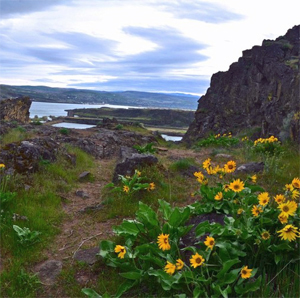Find a Safe, Snow-Free Trail to Hike
Spring is a tricky season for hikers and snowshoers in the Northwest. Because temperatures fluctuate so widely, dangers from avalanches can actually increase around this time. Get tips on trails to avoid and ideas for a fun safe hike. Plus: strategies for navigating the common hazards of springtime hiking.
The avalanche tragedies near Snoqulamie Pass last weekend were a tough reminder that springtime in the Northwest is a tricky season for hikers and snowshoers. Because temperatures fluctuate so dramatically, dangers from avalanches can increase quickly around this time. But that doesn't mean you can't find a great, safe hike.
Below are strategies for navigating the hazards of springtime hiking and some examples of the type of trails best avoided this time of year.
Research conditions and go prepared
- Call ahead to ranger stations and check WTA trip reports for current conditions, remembering that trip reports are hiker-generated, and all hikers have different skills and experience.
- Check the National Weather Service's mountains forecast page and the Northwest Weather and Avalanche Center avalanche forecasts. If you're not sure how to read the snow levels along Snoqualmie or other destinations, just pick a hike that's sure to be snow-free.
- Rapidly-changing weather, lingering snow, rain, rising rivers, mud, blown-down trees and bad roads are all potential spring hiking hazards. Learn how to handle them.
- When trails are obscured by snow, it's easy to lose your way. Unless you're adept with off-trail travel with map and compass, it's usually a good idea to turn back at snow line.
- Every hiking party should carry the Ten Essentials, including maps, a compass and a refreshed First Aid kit. Throw in some extra clothing (especially rain gear) and extra food and water.
Trails to save for summer: avoid avalanche dangers
If you're not an expert at reading avalanche risk factors or snowfield conditions, call or visit a local ranger station to find out if the trail or route you want to take is prone to avalanches or other kinds of hazards. Many trails that are easy day hikes in summer can be deadly in winter or spring, including the following trails:
- Granite Mountain: This snowshoe can be a tempting choice because it's so close to Seattle, but the trail crosses a known avalanche chute, so it's best avoided this time of year.
- Big Four Ice Caves: Winter, summer, spring or fall, it is never safe to enter an ice cave, no matter how stable they might seem. In addition to spontaneous collapse, there is high risk in winter from avalanches off the mountain that feeds these caves.
- Lake 22: A great day hike in summer, it can be avalanche prone in winter. It's best to wait until the snow is melted on this popular Mountain Loop Highway trail.
- Mount Dickerman: The steep, sheer cliffs at the top of this trail offer stunning views in summer, but can pose dangers to hikers punching through features like cornices and thawing ice bridges in winter and spring.
- Snow Lake and Source Lake are both Snoqualmie corridor snowshoes with the potential for considerable avalanche dangers depending on conditions.
- Mount Pilchuck: Snow lingers later than you might think (into June) on this popular trail, leading to injuries every season, most often from hikers punching through snow and ice bridges covering large boulders near the top. If you want to beat the crowds on this popular hike, don't feel like you need to rush the season. Just tackle it on an early summer morning in July or August.
- Iron Goat Trail: A rail trail close to Stevens Pass, this trail is lined with avalanche chutes. Take a walk along this one only once the avalanche danger is low or the snow is gone completely.
These trails are just examples what to beware of this time of year. When in doubt, ask a ranger or choose from one of the great snow-free hikes below.
Hike these snow-free hikes instead

Is there still snow on trail? In Washington state, hikers may be asking that question well into July.
While you wait for the high country to melt, explore the many other wonders, from waterfalls to wildflowers, of Washington hiking.
- Follow the wildflowers. Head towards Yakima or south to Coyote Wall and Horsethief Butte in Columbia Hills State Park along the Columbia River Gorge.
- Try one of these seasonal suggestions.
- Check trip reports for more great hike ideas and file your own trip reports. We're safer when we work together.


Comments